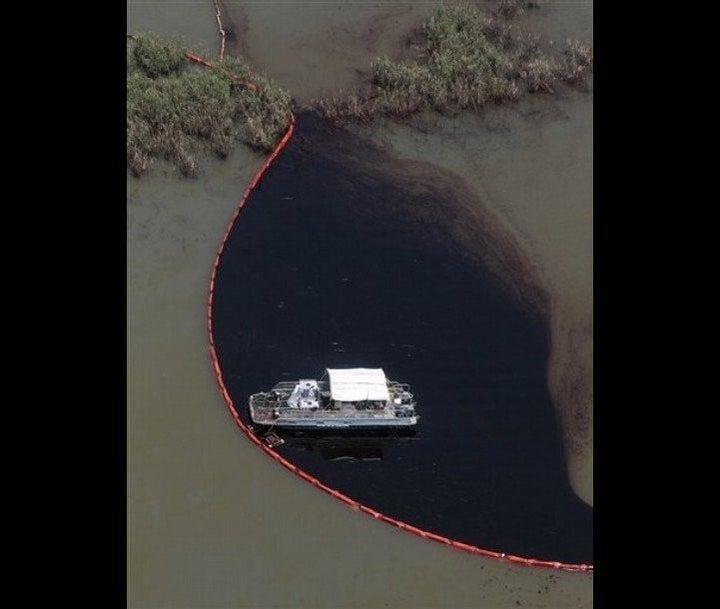
An oceanographer just back from two weeks of taking water samples in the Gulf of Mexico told a House panel on Wednesday that BP officials are utterly wrong to keep saying there are no large masses of oil lurking below the surface.
"I think part of the problem is that it depends on what the definition of 'large' is," said Samantha Joye, a senior marine scientist at the University of Georgia. "I don't know what their definition of large is, but I'll bet it's not the same as mine."
Joye's instruments, deployed from a University of Miami research vessel, the Walton Smith, detected both the presence of oil and the depletion of oxygen in very deep water -- 900 to 1200 meters below the surface -- in a plume five to eight miles away from the leak site. As she explained in an interview: "All of the sensors we have to pick up oil and its various components go crazy in the plume."
Lab results from one of the first research vessels doing subsurface tests found only minor concentrations of oil, but Joye, who is expecting test results back shortly, said her samples will inevitably show more than that. "These stank to high heaven," she said. "They smelled like creosote, asphalt and diesel."
"These plumes are real," she said, "and it's not just oil." Joye, who blogged her research, said she is also very concerned about the concentrations of methane and other gases, such as ethane, propane, butane and pentane, in the water.
BP officials have routinely tried to wave off the notion that much of the oil spewed from their blown out well is suspended in the water column, killing wide swaths of sea-life in the short run, and possibly endangering coastlines for decades to come.
The latest denial came Wednesday morning as BP Chief Operating Officer Doug Suttles told NBC "we haven't found any large concentrations of oil under the sea, and to my knowledge no one has."
But Massachusetts Rep. Ed Markey, whose House Energy subcommittee held Wednesday's briefing, said afterward in a statement to the Huffington Post: "It's said that sound travels for miles underwater, yet BP continues to be completely deaf when it comes to warnings from scientists about these underwater plumes. NOAA has found them. Independent scientists have seen them, even smelled them. When will BP finally listen?"
Another witness before Markey's subcommittee had actually taken a swim through underwater oil -- though much closer to the surface. Philippe Cousteau, the grandson of the famous oceanographer, showed members of Congress video of his dive through "swirls of this orange, toxic soup" that he described as "one of the most horrible things I've ever seen underwater."
The Obama administration, while at long last officially confirming the presence of some underwater oil, is still not exactly going out of its way to contradict BP, either. At a press briefing yesterday, Coast Guard Adm. Thad Allen insisted that, rather than plume, "a cloud is a better term."
Joye dismissed the distinction between clouds and plumes as "semantics."
In her presentation, she pointed out that the deepwater oxygen depletion caused by the plume could well be a much longer lasting problem than oxygen depletion close to the surface, which can be replenished by photosynthesis and fast currents. Deepwater "dead zones" could last for years -- "likely decades."
And Joye called on NOAA to get more resources out onto the gulf to measure subsea oil. "I think they need dozens of ships."
But more than anything, she said, what scientists need to know is precisely how much oil and gas has leaked. Neither BP nor the Obama administration have been forthcoming on that front. Joye wrote:
It is virtually impossible to understand or quantify the ecological consequences of the BP blowout on the Gulf of Mexico ecosystem without knowing how much oil and gas has leaked from the wellhead. These numbers need to be estimated and corroborated independently based on available observational data. Unfortunately, the leak rate was not quantified robustly during the first month of the spill (at least that information has not been made publically available). Unless we know how much oil is leaking from the wellhead, we cannot gauge the full extent of the ecological consequences in deepwater or surface water environments. For example, how much deepwater water column oxygen consumption will be fueled by this influx of oil and gas? Which water column microbial communities will be stimulated by oil and gas? What is the time scale of this response? How will surface water microbial communities respond to surface oil and gas inputs? Potential fishery, marine mammal, and wildlife consequences of the BP blowout cannot be properly predicted until we know the magnitude of the disaster. To put it bluntly, the scientific community is hamstrung until we know precisely how much oil and gas has leaked and is leaking from the wellhead.
Or, as she put it to HuffPost: "We need to get that number!"
*************************
Dan Froomkin is senior Washington correspondent for the Huffington Post. You can send him an e-mail, bookmark his page; subscribe to RSS feed, follow him on Twitter, friend him on Facebook, and/or become a fan and get e-mail alerts when he writes.
